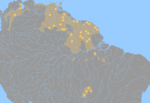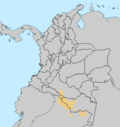Proto-Tupian (PT) is the reconstructed common ancestor of all the Tupian languages. It consists, therefore, of a hypothetical language, reconstructed by...
10 KB (601 words) - 00:38, 18 January 2024
these languages and maybe of its speaking peoples. Rodrigues believes the Proto-Tupian language dates back to around 3,000 BC. Tupian languages have extensively...
26 KB (1,186 words) - 20:23, 19 December 2023
Proto-Mixtec [es] Proto-Tucanoan [ru] Proto-Tupian Proto-Macro-Jê [pt] Proto-Arawakan [pt] Proto-Siouan These are hypothetical proto-languages that cannot be substantiated...
5 KB (364 words) - 01:00, 12 February 2024
among Jê, Tupian, Cariban, Arawakan, and Trumai languages is also evident among the languages of the Xingu Indigenous Park. Comparison of Proto-Macro-Jê...
18 KB (981 words) - 04:35, 18 April 2024
quite clear that Tupian languages expanded from Rondônia, which is an area of greater diversification; in fact, almost all Tupian languages outside of Rondônia...
62 KB (4,809 words) - 10:48, 8 February 2024
needed] Meira, Gildea, & Hoff (2010) note that likely morphemes in proto-Tupian and proto-Cariban are good candidates for being cognates, but that work so...
74 KB (1,733 words) - 15:36, 9 July 2024
of Nilo-Saharan languages may have unified around 7000 years ago. Aryon Rodrigues hypothesizes the emergence of a Proto-Tupian language between the Guaporé...
120 KB (14,559 words) - 17:45, 3 August 2024
most widely distributed subfamily of the Tupian languages of South America. It consists of about fifty languages, including Guarani and Old Tupi. The most...
50 KB (1,121 words) - 18:48, 28 August 2024
The Yuruna languages (or Jurúna languages) of Brazil form a branch of the Tupian language family. They are Jurúna, Maritsauá, and Xipaya. Below is a list...
2 KB (170 words) - 01:42, 20 December 2021
similarities with the Arawakan, Tupian, Trumai, and Ofayé language families due to contact, pointing to an origin of Proto-Mataguayo-Guaicuruan in the Upper...
6 KB (492 words) - 17:03, 5 January 2024
‘White man’).: 10–2 The phonology of the Tapirapé language originated in the Proto-Tupian language. Among its main features, the presence of alternation...
8 KB (705 words) - 08:01, 3 June 2024
Gordon (2005) follows Stark. Mason (1950: 236–238) groups Bora–Witoto, Tupian, and Zaparoan together as part of a proposed Macro-Tupí-Guaranían family...
13 KB (947 words) - 17:29, 5 January 2024
Andoque, Proto-Cariban and Yagua, and found Bora-Witoto to be not related to any of the others. Mason (1950: 236–238) groups Bora–Witoto, Tupian, and Zaparoan...
7 KB (526 words) - 21:27, 5 May 2024
to the breakup of linguistic unity. Tupian Proto-Tupian, the reconstructed common ancestor of the Tupian languages of South America, was probably spoken...
45 KB (4,988 words) - 17:14, 23 June 2024
similarities with Bororoan, Kariri, and Chiquitano, of the kind also shared with Tupian and Cariban, but little lexical evidence. Jolkesky (2016) proposes the following...
19 KB (1,604 words) - 17:36, 5 January 2024
The term General Language (Portuguese: língua geral) refers to lingua francas that emerged in South America during the 16th and 17th centuries, the two...
2 KB (178 words) - 10:54, 11 August 2024
blue/green are also found in Mayan languages; for example, in the Yucatec Maya language, yax is 'blue/green'. Tupian languages did not originally differ between...
69 KB (7,841 words) - 16:25, 22 August 2024
Consciously devised language Endangered language – Language that is at risk of going extinct Ethnologue#Language families Extinct language – Language that no longer...
36 KB (226 words) - 01:26, 6 August 2024
first two centuries of colonization, a language based on Tupian languages known as Língua Geral ("General Language") was widely spoken in the colony, not...
111 KB (8,690 words) - 07:07, 14 August 2024
Puinave-Nadahup languages, Jolkesky (2016) notes that there are lexical similarities with the Tupian, Harakmbet, Katukina-Katawixi, Arawak, and Karaja language families...
6 KB (683 words) - 17:47, 10 October 2022
The Tuparí languages of Brazil form a branch of the Tupian language family. The Tupari languages are: Tupari Makuráp Nuclear Tupari Akuntsu–Mekéns (Sakirabiá...
10 KB (595 words) - 16:56, 5 January 2024
Canela (Macro-Jê) Georgian (Kartvelian) Greenlandic (Eskimo-Aleut) Guarani (Tupian) Japanese (Japonic) Karuk (Hokan) Khmer (Austroasiatic) Korean (Koreanic)...
26 KB (2,168 words) - 20:53, 16 August 2024
Andean–Equatorial Andean Jivaroan Macro-Tucanoan Equatorial (with Macro-Arawakan and Tupian) Ge–Pano–Carib Macro-Ge Macro-Panoan Macro-Carib Nambikwara Huarpe Taruma...
29 KB (2,444 words) - 00:17, 16 August 2024
Mamoré–Guaporé linguistic area (redirect from Mamoré-Guaporé languages)
varieties Tupian branches in the Mamoré–Guaporé linguistic area are: Ramarama languages Puruborá language Mondé languages Tupari languages Arikem languages Guarayo...
17 KB (688 words) - 05:50, 3 April 2023
The Paulista General Language, also called Southern General Language and Austral Tupi, was a lingua franca and creole language formed in the 16th century...
12 KB (1,535 words) - 23:17, 8 August 2024
The Mundurukú languages of Brazil form a branch of the Tupian language family. They are Munduruku and the extinct Kuruáya. Loukotka (1968) lists the following...
3 KB (112 words) - 21:37, 4 December 2020
Tiníwan, Pamiguan) † Trumai (Brazil: Xingu, Mato Grosso) Tucanoan (15) Tupian (70, including Guaraní) Tuxá (Brazil: Bahia, Pernambuco) † Urarina (also...
103 KB (6,596 words) - 15:28, 23 August 2024
Panoan (also Pánoan, Panoano, Panoana, Páno) is a family of languages spoken in western Brazil, eastern Peru, and northern Bolivia. It is possibly a branch...
51 KB (2,921 words) - 01:12, 8 January 2024
of the Yuruna languages. Juruna at Ethnologue (18th ed., 2015) (subscription required) Carvalho, Fernando O. de. 2019. Revisitando o Proto-Jurúna: a reconstrução...
3 KB (169 words) - 20:01, 28 July 2022
The Maweti–Guarani languages of Brazil form a branch of the Tupian language family according to Meira and Drude (2015). The branch was originally proposed...
11 KB (255 words) - 03:39, 10 July 2024













